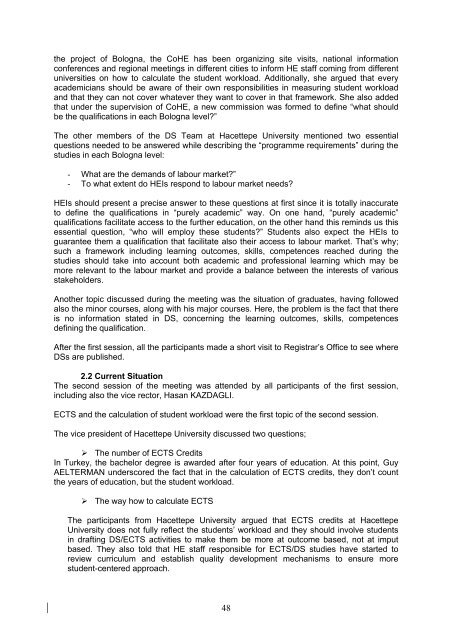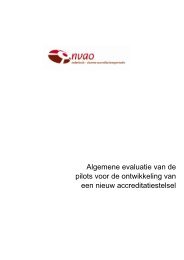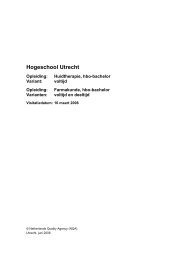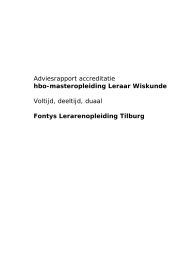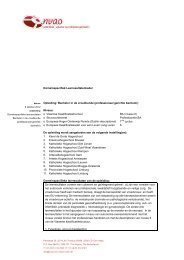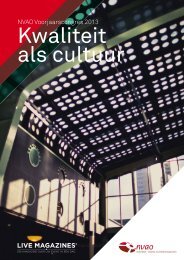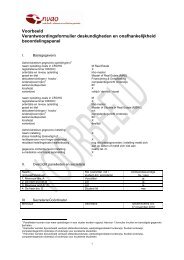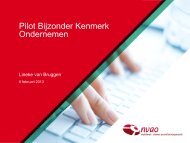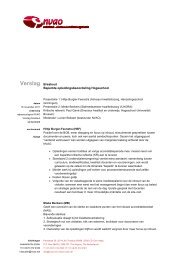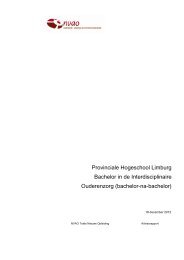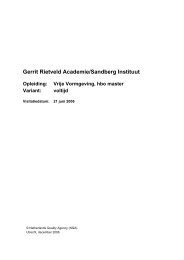Study on the Diploma Supplement as seen by its users - naric
Study on the Diploma Supplement as seen by its users - naric
Study on the Diploma Supplement as seen by its users - naric
You also want an ePaper? Increase the reach of your titles
YUMPU automatically turns print PDFs into web optimized ePapers that Google loves.
<strong>the</strong> project of Bologna, <strong>the</strong> CoHE h<strong>as</strong> been organizing site vis<strong>its</strong>, nati<strong>on</strong>al informati<strong>on</strong><br />
c<strong>on</strong>ferences and regi<strong>on</strong>al meetings in different cities to inform HE staff coming from different<br />
universities <strong>on</strong> how to calculate <strong>the</strong> student workload. Additi<strong>on</strong>ally, she argued that every<br />
academicians should be aware of <strong>the</strong>ir own resp<strong>on</strong>sibilities in me<strong>as</strong>uring student workload<br />
and that <strong>the</strong>y can not cover whatever <strong>the</strong>y want to cover in that framework. She also added<br />
that under <strong>the</strong> supervisi<strong>on</strong> of CoHE, a new commissi<strong>on</strong> w<strong>as</strong> formed to define “what should<br />
be <strong>the</strong> qualificati<strong>on</strong>s in each Bologna level?”<br />
The o<strong>the</strong>r members of <strong>the</strong> DS Team at Hacettepe University menti<strong>on</strong>ed two essential<br />
questi<strong>on</strong>s needed to be answered while describing <strong>the</strong> “programme requirements” during <strong>the</strong><br />
studies in each Bologna level:<br />
- What are <strong>the</strong> demands of labour market?”<br />
- To what extent do HEIs resp<strong>on</strong>d to labour market needs?<br />
HEIs should present a precise answer to <strong>the</strong>se questi<strong>on</strong>s at first since it is totally inaccurate<br />
to define <strong>the</strong> qualificati<strong>on</strong>s in “purely academic” way. On <strong>on</strong>e hand, “purely academic”<br />
qualificati<strong>on</strong>s facilitate access to <strong>the</strong> fur<strong>the</strong>r educati<strong>on</strong>, <strong>on</strong> <strong>the</strong> o<strong>the</strong>r hand this reminds us this<br />
essential questi<strong>on</strong>, “who will employ <strong>the</strong>se students?” Students also expect <strong>the</strong> HEIs to<br />
guarantee <strong>the</strong>m a qualificati<strong>on</strong> that facilitate also <strong>the</strong>ir access to labour market. That’s why;<br />
such a framework including learning outcomes, skills, competences reached during <strong>the</strong><br />
studies should take into account both academic and professi<strong>on</strong>al learning which may be<br />
more relevant to <strong>the</strong> labour market and provide a balance between <strong>the</strong> interests of various<br />
stakeholders.<br />
Ano<strong>the</strong>r topic discussed during <strong>the</strong> meeting w<strong>as</strong> <strong>the</strong> situati<strong>on</strong> of graduates, having followed<br />
also <strong>the</strong> minor courses, al<strong>on</strong>g with his major courses. Here, <strong>the</strong> problem is <strong>the</strong> fact that <strong>the</strong>re<br />
is no informati<strong>on</strong> stated in DS, c<strong>on</strong>cerning <strong>the</strong> learning outcomes, skills, competences<br />
defining <strong>the</strong> qualificati<strong>on</strong>.<br />
After <strong>the</strong> first sessi<strong>on</strong>, all <strong>the</strong> participants made a short visit to Registrar’s Office to see where<br />
DSs are published.<br />
2.2 Current Situati<strong>on</strong><br />
The sec<strong>on</strong>d sessi<strong>on</strong> of <strong>the</strong> meeting w<strong>as</strong> attended <strong>by</strong> all participants of <strong>the</strong> first sessi<strong>on</strong>,<br />
including also <strong>the</strong> vice rector, H<strong>as</strong>an KAZDAGLI.<br />
ECTS and <strong>the</strong> calculati<strong>on</strong> of student workload were <strong>the</strong> first topic of <strong>the</strong> sec<strong>on</strong>d sessi<strong>on</strong>.<br />
The vice president of Hacettepe University discussed two questi<strong>on</strong>s;<br />
‣ The number of ECTS Cred<strong>its</strong><br />
In Turkey, <strong>the</strong> bachelor degree is awarded after four years of educati<strong>on</strong>. At this point, Guy<br />
AELTERMAN underscored <strong>the</strong> fact that in <strong>the</strong> calculati<strong>on</strong> of ECTS cred<strong>its</strong>, <strong>the</strong>y d<strong>on</strong>’t count<br />
<strong>the</strong> years of educati<strong>on</strong>, but <strong>the</strong> student workload.<br />
‣ The way how to calculate ECTS<br />
The participants from Hacettepe University argued that ECTS cred<strong>its</strong> at Hacettepe<br />
University does not fully reflect <strong>the</strong> students’ workload and <strong>the</strong>y should involve students<br />
in drafting DS/ECTS activities to make <strong>the</strong>m be more at outcome b<strong>as</strong>ed, not at imput<br />
b<strong>as</strong>ed. They also told that HE staff resp<strong>on</strong>sible for ECTS/DS studies have started to<br />
review curriculum and establish quality development mechanisms to ensure more<br />
student-centered approach.<br />
48


